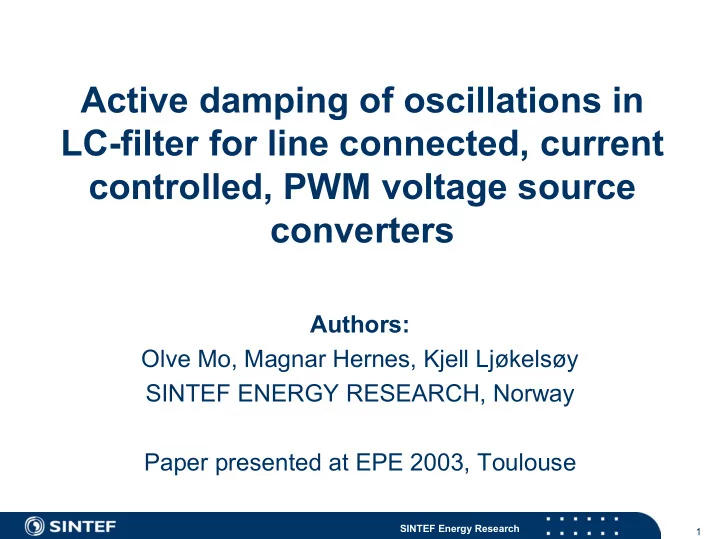

Active damping of oscillations in LC-filter for line connected, current controlled, PWM voltage source converters Authors: Olve Mo, Magnar Hernes, Kjell Ljøkelsøy SINTEF ENERGY RESEARCH, Norway Paper presented at EPE 2003, Toulouse SINTEF Energy Research 1
The challenge � A low pass LC-filter is a commonly used method to reduce the switching ripple currents and voltages at the terminals of line connected PWM converters � The LC-filter introduces risk of oscillations in converter terminal voltage due to resonance between LC-filter capacitor and AC-grid reactance � Oscillations can be initiated by nearby load changes or by periodic disturbances in the grid (e.g. thyristor rectifiers). � The challenge is to modify the control system in such a way that oscillations are damped without affecting the basic control tasks of the converter SINTEF Energy Research 2
Applicability � Filter oscillations is most likely to be a problem when the natural frequency of the oscillation is low (poorly damped) � The worst cases will typical be those were the converter rating becomes comparable to the upstream transformer (or generator) rating. � A typical example is emergency operation of isolated grids were converter ratings may become comparable to the emergency generator ratings. � Other examples are ship and offshore power systems and distributed production units connected to a weak grid. SINTEF Energy Research 3
The power circuit � Current controlled, line connected, PWM voltage source converter (For instance operated as active rectifier / inverter, STATCOM or active filter) � The focused oscillation are illustrated by red arrows in the figure AC-grid Optionally i a connected to + U DC DC-source / i b DC-load i c + + + u a u b u c SINTEF Energy Research 4
Control system � Closed loop control of filter inductor current and DC-link voltage, PWM � Measures DC-link voltage, minimum two filter inductor currents and two line voltages. � Synchronisation by phase locked loop � Active damping is an ”add-on feature” (red in the figure) u dc,measure i a/b/c,ref,mod i reactive,ref * Inverse i a/b/c,ref Gate pulses + _ + + - H reg,cur (s) park u dc,ref * PWM i active H reg,DC (s) + transf. i active,ref * Phase θ i a/b/c,damp Active i a/b/c,measure locked u a/b/c,measure damping loop SINTEF Energy Research 5
The active damping method � The oscillating component of the capacitor voltage is extracted (the non-fundamental component) � The error in the capacitor voltage is found by subtracting the oscillating component from its reference (=0) � The error is amplified and added to the reference signal for the current controller. θ ( from phase locked loop) Inverse u a/b/c,fundamental,+ Low pass Park u a/b/c,measure Park filter transf. u cos+ u cos+,filtered transf. u sin+ u sin+,filtered - + u a/b/c,oscillation - i a/b/c,damp u a/b/c,oscillation,ref * (= 0) H reg,damp (s) + SINTEF Energy Research 6
Demonstration by simulation � Application: PWM converter connected to the AC-grid at a point with low short circuit capacity compared to converter kVA rating � Demonstration of damping of oscillations after a step reversal of the reference for reactive current PWM LC-filter converter Ideal AC Network I mains I measure 1 : 1 - 40 dB at f sw V DC = 450 V f grid = 50 Hz S conv = 20 kVA L=0.82mH S transf = 30 kVA v grid = 230 V rms (l-l) C=100 µ F f sw = 5470 Hz x transf = 10 % R C =1.0m Ω L=0.6mH, R L =6.4m Ω R=100m Ω SINTEF Energy Research 7
Active damping disabled Active damping enabled ua ia,mains ua ia,mains +0.25 +0.25 Phase a filter +0.15 +0.15 capacitor voltage (black) +0.05 +0.05 -0.05 -0.05 Phase a current -0.15 -0.15 into AC-grid (red) -0.25 -0.25 0.13 0.142 0.154 0.166 0.178 0.19 0.13 0.142 0.154 0.166 0.178 0.19 Time (sec) Time (sec) ua ub uc ua ub uc +0.25 +0.25 +0.15 +0.15 Filter capacitor +0.05 +0.05 voltages -0.05 -0.05 (phase a, b, c) -0.15 -0.15 -0.25 -0.25 0.14 0.144 0.148 0.152 0.156 0.16 0.14 0.144 0.148 0.152 0.156 0.16 Time (sec) Time (sec) SINTEF Energy Research 8
Laboratory demonstration � Converter connected to a weak bus � Three-phase diode rectifier connected to the same bus � Measurements demonstrates that the active damping suppresses LC-filter filter oscillations trigged by the harmonics of the diode rectifier PWM Transformer (ref. 230V) LC-filter converter L transf = 650 µ H Bus A i measure R transf = 130m Ω at 50Hz, 300m Ω at 600Hz i transf i mains AC Network V DC = 400 V L=0.82mH 230:400 f grid = 50 Hz f sw = 5470 Hz C=100 µ F v grid = 400 V rms (l-l) C DC =3300 µ F R C =1.0m Ω 3-phase diode (no load or R L =6.4m Ω rectifier source R load,serial = 28.5 Ω i diode connected to L load,serial =1.2mH DC-link) (no commutation reactance) SINTEF Energy Research 9
Active damping disabled Active damping enabled Phase voltage at bus A (black) Transformer current (red) SINTEF Energy Research 10
Conclusions � Introduction of active damping is a possible measure for reduction of oscillations due to low pass LC-filters of line connected current controlled PWM converters � Simulations and measurements show that the method works as intended � The voltage quality at the point of connection can be maintained in cases were filter oscillations is to be expected when the low pass LC-filter is introduced SINTEF Energy Research 11
Recommend
More recommend